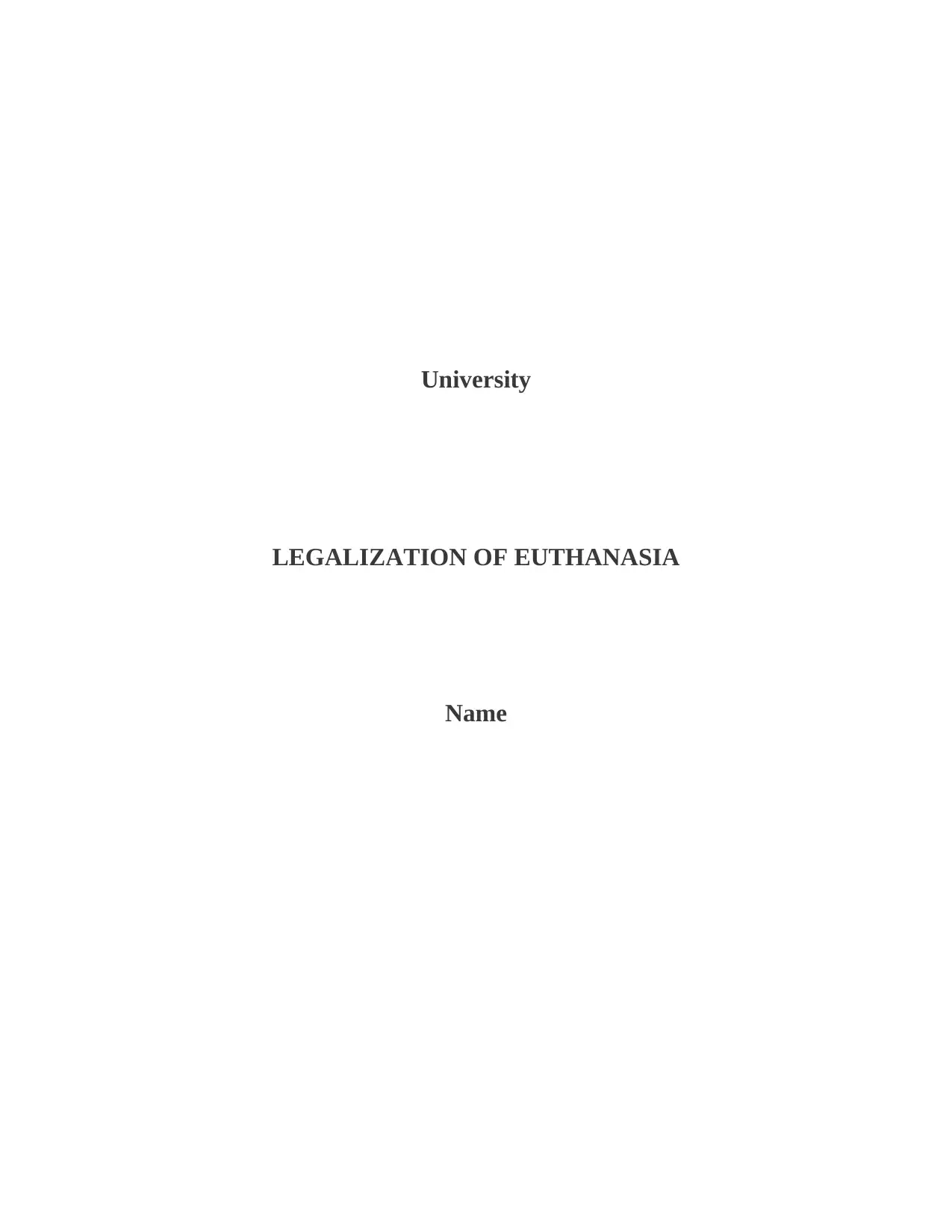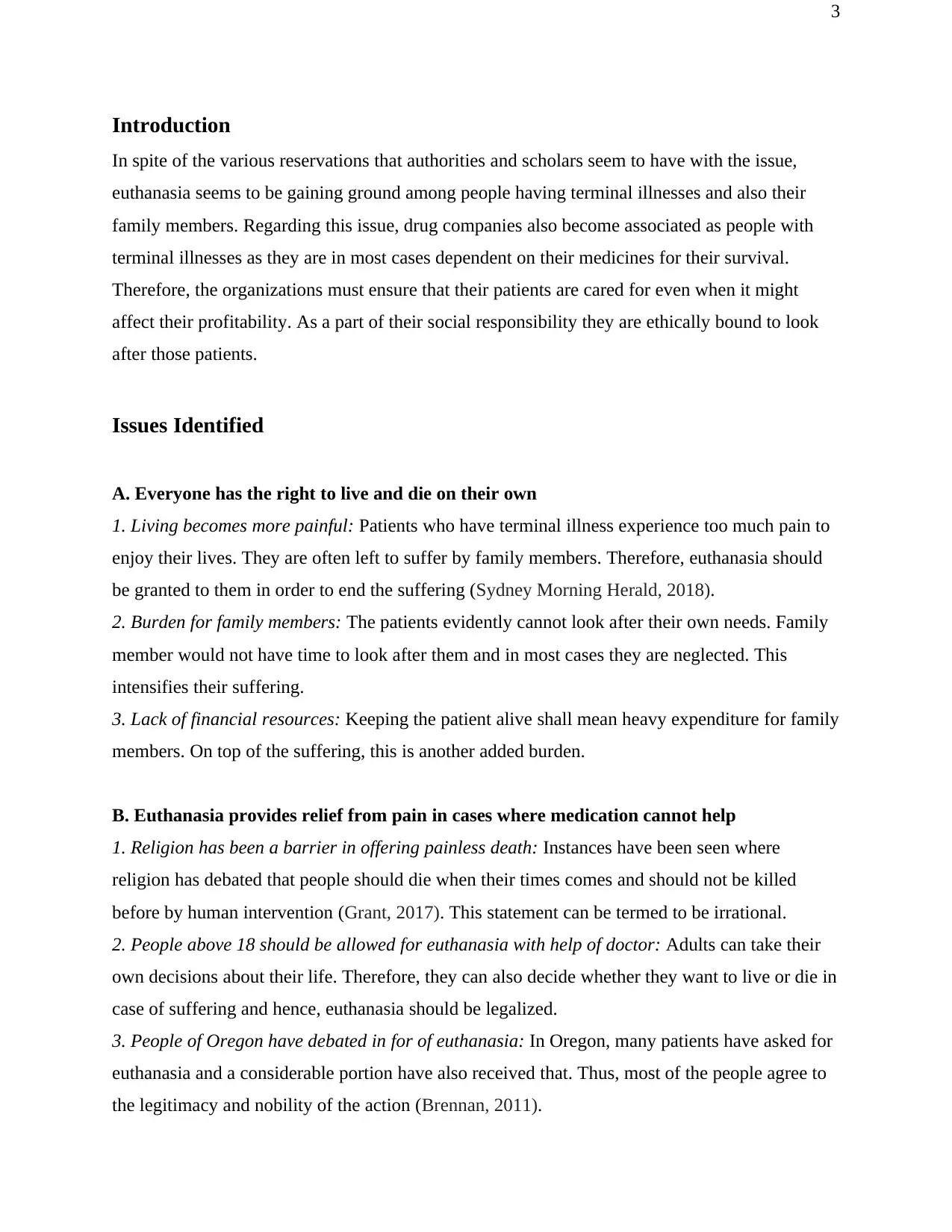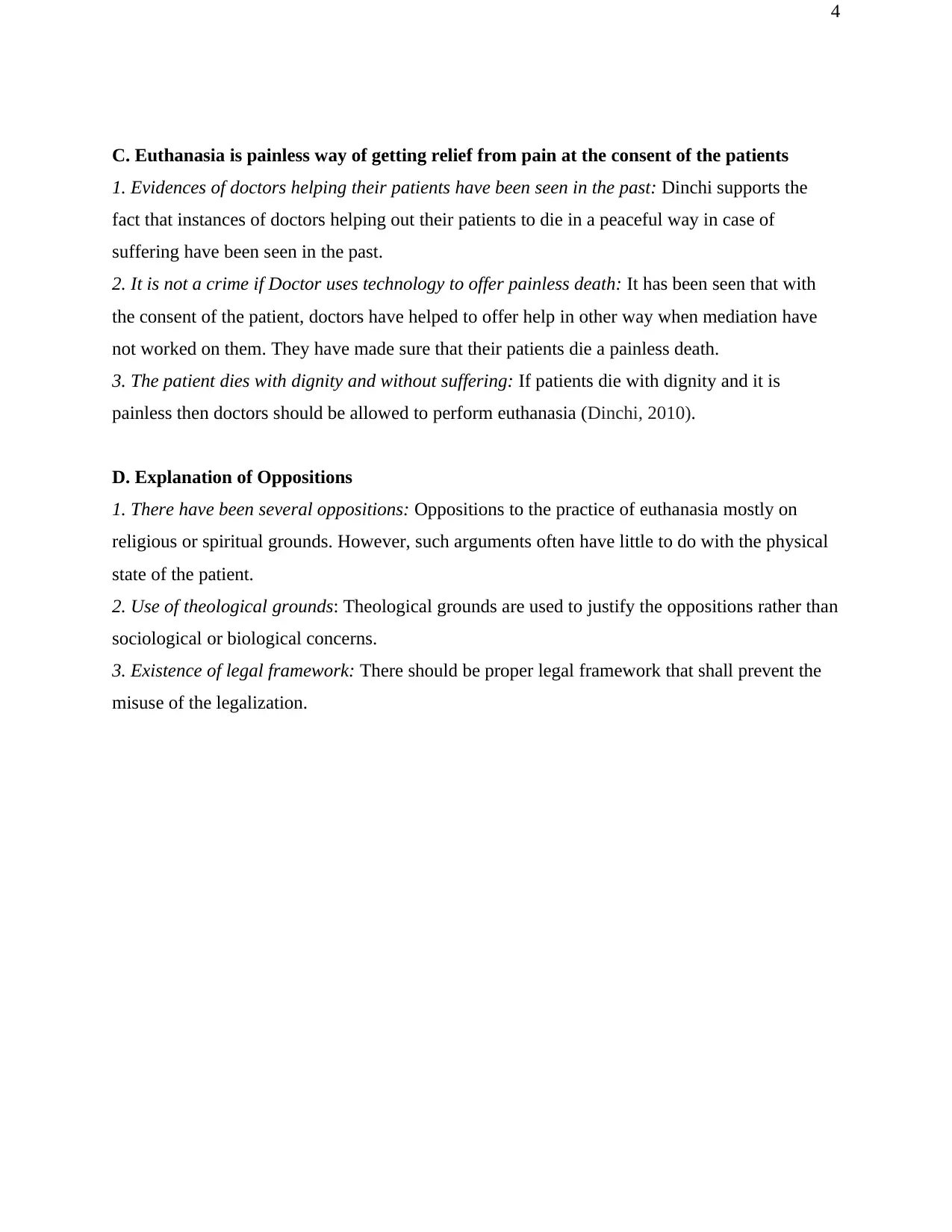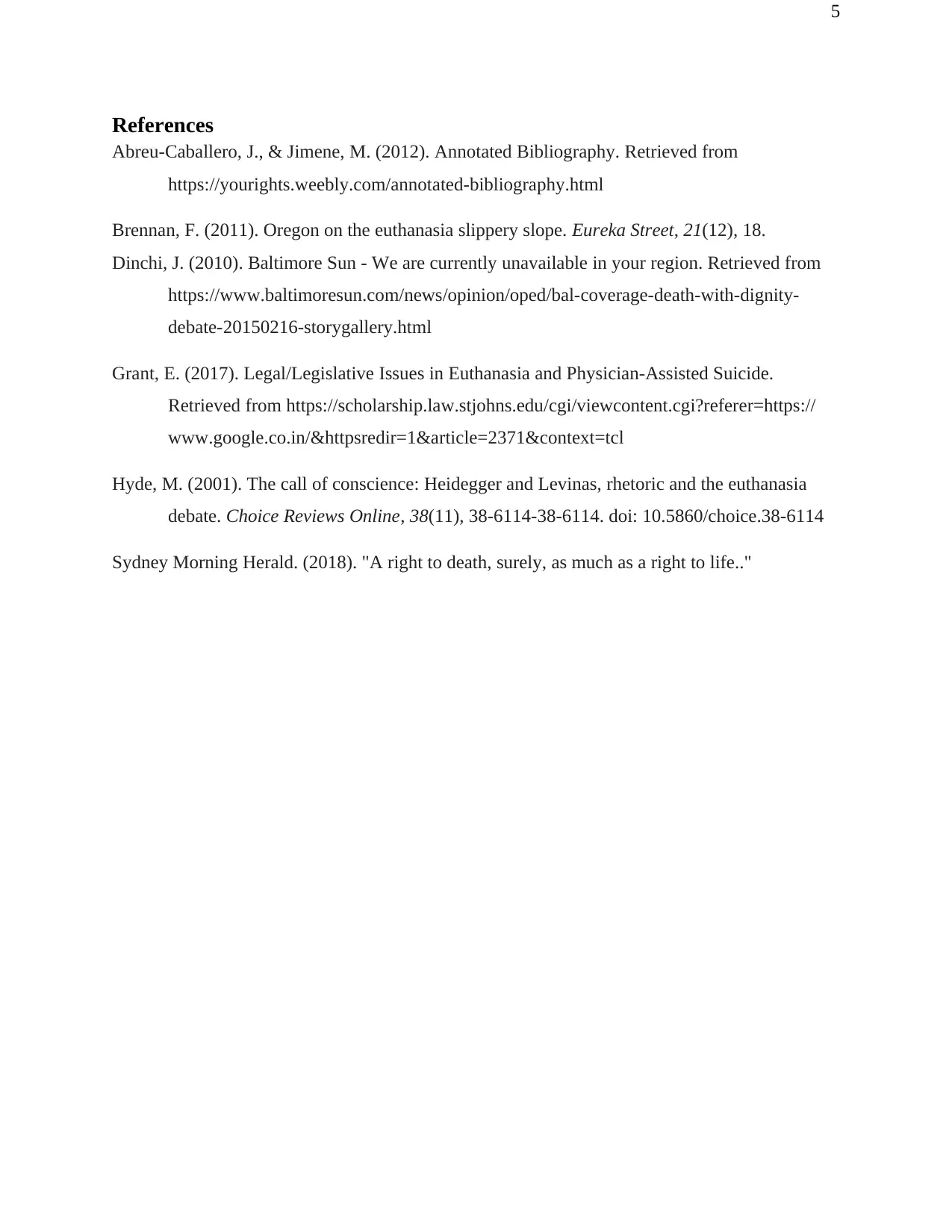Research Essay: Legalization of Euthanasia and Ethical Considerations
VerifiedAdded on 2023/05/31
|5
|822
|395
Essay
AI Summary
This essay delves into the contentious issue of euthanasia legalization, examining the arguments for and against it. The introduction presents the topic, thesis, and opposing viewpoints, setting the stage for a detailed analysis. The body of the essay explores key issues, including the right to live and die, the relief from pain, and the role of patient consent. It also addresses common oppositions to euthanasia, such as religious and theological grounds, and discusses the need for a proper legal framework to prevent misuse. The essay references several sources to support its arguments, providing a comprehensive overview of the ethical, legal, and societal implications of euthanasia.

University
LEGALIZATION OF EUTHANASIA
Name
LEGALIZATION OF EUTHANASIA
Name
Paraphrase This Document
Need a fresh take? Get an instant paraphrase of this document with our AI Paraphraser

2
Table of Contents
Introduction 3
Issues Identified 3
References 5
Table of Contents
Introduction 3
Issues Identified 3
References 5

3
Introduction
In spite of the various reservations that authorities and scholars seem to have with the issue,
euthanasia seems to be gaining ground among people having terminal illnesses and also their
family members. Regarding this issue, drug companies also become associated as people with
terminal illnesses as they are in most cases dependent on their medicines for their survival.
Therefore, the organizations must ensure that their patients are cared for even when it might
affect their profitability. As a part of their social responsibility they are ethically bound to look
after those patients.
Issues Identified
A. Everyone has the right to live and die on their own
1. Living becomes more painful: Patients who have terminal illness experience too much pain to
enjoy their lives. They are often left to suffer by family members. Therefore, euthanasia should
be granted to them in order to end the suffering (Sydney Morning Herald, 2018).
2. Burden for family members: The patients evidently cannot look after their own needs. Family
member would not have time to look after them and in most cases they are neglected. This
intensifies their suffering.
3. Lack of financial resources: Keeping the patient alive shall mean heavy expenditure for family
members. On top of the suffering, this is another added burden.
B. Euthanasia provides relief from pain in cases where medication cannot help
1. Religion has been a barrier in offering painless death: Instances have been seen where
religion has debated that people should die when their times comes and should not be killed
before by human intervention (Grant, 2017). This statement can be termed to be irrational.
2. People above 18 should be allowed for euthanasia with help of doctor: Adults can take their
own decisions about their life. Therefore, they can also decide whether they want to live or die in
case of suffering and hence, euthanasia should be legalized.
3. People of Oregon have debated in for of euthanasia: In Oregon, many patients have asked for
euthanasia and a considerable portion have also received that. Thus, most of the people agree to
the legitimacy and nobility of the action (Brennan, 2011).
Introduction
In spite of the various reservations that authorities and scholars seem to have with the issue,
euthanasia seems to be gaining ground among people having terminal illnesses and also their
family members. Regarding this issue, drug companies also become associated as people with
terminal illnesses as they are in most cases dependent on their medicines for their survival.
Therefore, the organizations must ensure that their patients are cared for even when it might
affect their profitability. As a part of their social responsibility they are ethically bound to look
after those patients.
Issues Identified
A. Everyone has the right to live and die on their own
1. Living becomes more painful: Patients who have terminal illness experience too much pain to
enjoy their lives. They are often left to suffer by family members. Therefore, euthanasia should
be granted to them in order to end the suffering (Sydney Morning Herald, 2018).
2. Burden for family members: The patients evidently cannot look after their own needs. Family
member would not have time to look after them and in most cases they are neglected. This
intensifies their suffering.
3. Lack of financial resources: Keeping the patient alive shall mean heavy expenditure for family
members. On top of the suffering, this is another added burden.
B. Euthanasia provides relief from pain in cases where medication cannot help
1. Religion has been a barrier in offering painless death: Instances have been seen where
religion has debated that people should die when their times comes and should not be killed
before by human intervention (Grant, 2017). This statement can be termed to be irrational.
2. People above 18 should be allowed for euthanasia with help of doctor: Adults can take their
own decisions about their life. Therefore, they can also decide whether they want to live or die in
case of suffering and hence, euthanasia should be legalized.
3. People of Oregon have debated in for of euthanasia: In Oregon, many patients have asked for
euthanasia and a considerable portion have also received that. Thus, most of the people agree to
the legitimacy and nobility of the action (Brennan, 2011).
⊘ This is a preview!⊘
Do you want full access?
Subscribe today to unlock all pages.

Trusted by 1+ million students worldwide

4
C. Euthanasia is painless way of getting relief from pain at the consent of the patients
1. Evidences of doctors helping their patients have been seen in the past: Dinchi supports the
fact that instances of doctors helping out their patients to die in a peaceful way in case of
suffering have been seen in the past.
2. It is not a crime if Doctor uses technology to offer painless death: It has been seen that with
the consent of the patient, doctors have helped to offer help in other way when mediation have
not worked on them. They have made sure that their patients die a painless death.
3. The patient dies with dignity and without suffering: If patients die with dignity and it is
painless then doctors should be allowed to perform euthanasia (Dinchi, 2010).
D. Explanation of Oppositions
1. There have been several oppositions: Oppositions to the practice of euthanasia mostly on
religious or spiritual grounds. However, such arguments often have little to do with the physical
state of the patient.
2. Use of theological grounds: Theological grounds are used to justify the oppositions rather than
sociological or biological concerns.
3. Existence of legal framework: There should be proper legal framework that shall prevent the
misuse of the legalization.
C. Euthanasia is painless way of getting relief from pain at the consent of the patients
1. Evidences of doctors helping their patients have been seen in the past: Dinchi supports the
fact that instances of doctors helping out their patients to die in a peaceful way in case of
suffering have been seen in the past.
2. It is not a crime if Doctor uses technology to offer painless death: It has been seen that with
the consent of the patient, doctors have helped to offer help in other way when mediation have
not worked on them. They have made sure that their patients die a painless death.
3. The patient dies with dignity and without suffering: If patients die with dignity and it is
painless then doctors should be allowed to perform euthanasia (Dinchi, 2010).
D. Explanation of Oppositions
1. There have been several oppositions: Oppositions to the practice of euthanasia mostly on
religious or spiritual grounds. However, such arguments often have little to do with the physical
state of the patient.
2. Use of theological grounds: Theological grounds are used to justify the oppositions rather than
sociological or biological concerns.
3. Existence of legal framework: There should be proper legal framework that shall prevent the
misuse of the legalization.
Paraphrase This Document
Need a fresh take? Get an instant paraphrase of this document with our AI Paraphraser

5
References
Abreu-Caballero, J., & Jimene, M. (2012). Annotated Bibliography. Retrieved from
https://yourights.weebly.com/annotated-bibliography.html
Brennan, F. (2011). Oregon on the euthanasia slippery slope. Eureka Street, 21(12), 18.
Dinchi, J. (2010). Baltimore Sun - We are currently unavailable in your region. Retrieved from
https://www.baltimoresun.com/news/opinion/oped/bal-coverage-death-with-dignity-
debate-20150216-storygallery.html
Grant, E. (2017). Legal/Legislative Issues in Euthanasia and Physician-Assisted Suicide.
Retrieved from https://scholarship.law.stjohns.edu/cgi/viewcontent.cgi?referer=https://
www.google.co.in/&httpsredir=1&article=2371&context=tcl
Hyde, M. (2001). The call of conscience: Heidegger and Levinas, rhetoric and the euthanasia
debate. Choice Reviews Online, 38(11), 38-6114-38-6114. doi: 10.5860/choice.38-6114
Sydney Morning Herald. (2018). "A right to death, surely, as much as a right to life.."
References
Abreu-Caballero, J., & Jimene, M. (2012). Annotated Bibliography. Retrieved from
https://yourights.weebly.com/annotated-bibliography.html
Brennan, F. (2011). Oregon on the euthanasia slippery slope. Eureka Street, 21(12), 18.
Dinchi, J. (2010). Baltimore Sun - We are currently unavailable in your region. Retrieved from
https://www.baltimoresun.com/news/opinion/oped/bal-coverage-death-with-dignity-
debate-20150216-storygallery.html
Grant, E. (2017). Legal/Legislative Issues in Euthanasia and Physician-Assisted Suicide.
Retrieved from https://scholarship.law.stjohns.edu/cgi/viewcontent.cgi?referer=https://
www.google.co.in/&httpsredir=1&article=2371&context=tcl
Hyde, M. (2001). The call of conscience: Heidegger and Levinas, rhetoric and the euthanasia
debate. Choice Reviews Online, 38(11), 38-6114-38-6114. doi: 10.5860/choice.38-6114
Sydney Morning Herald. (2018). "A right to death, surely, as much as a right to life.."
1 out of 5
Related Documents
Your All-in-One AI-Powered Toolkit for Academic Success.
+13062052269
info@desklib.com
Available 24*7 on WhatsApp / Email
![[object Object]](/_next/static/media/star-bottom.7253800d.svg)
Unlock your academic potential
Copyright © 2020–2025 A2Z Services. All Rights Reserved. Developed and managed by ZUCOL.





